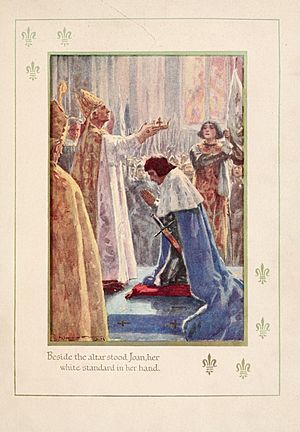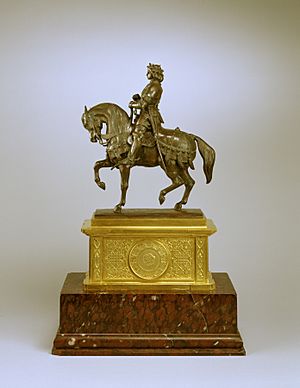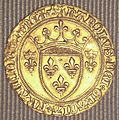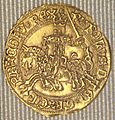Charles VII of France facts for kids
Quick facts for kids Charles VII |
|
|---|---|
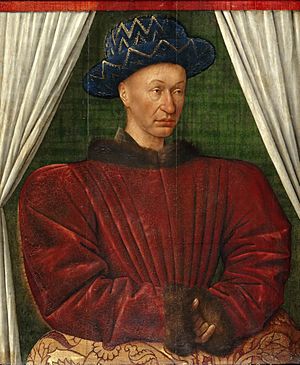
|
|
| King of France (more...) | |
| Reign | 21 October 1422 – 22 July 1461 |
| Coronation | 17 July 1429 |
| Predecessor | Charles VI |
| Successor | Louis XI |
| Born | 22 February 1403 Paris, France |
| Died | 22 July 1461 (aged 58) Mehun-sur-Yèvre, France |
| Burial | 7 August 1461 Saint Denis Basilica |
| Spouse | |
| Issue Detail |
|
| House | Valois |
| Father | Charles VI of France |
| Mother | Isabeau of Bavaria |
| Signature | |
Charles VII (born 22 February 1403 – died 22 July 1461) was the King of France from 1422 until his death. He was sometimes called the Victorious (le Victorieux) or the Well-Served (le Bien-Servi).
Charles VII became king during a very difficult time in French history. This was in the middle of the Hundred Years' War, a long conflict between France and England. English forces and their allies, the Duke of Burgundy, controlled much of northern France, including Paris. Even Reims, the city where French kings were traditionally crowned, was under their control.
To make things worse, Charles's father, King Charles VI, had said in 1420 that Charles could not be king. Instead, he recognized the English King Henry V of England and his family as the rightful rulers of France. At the same time, France was also in a civil war between two French groups: the Armagnacs, who supported Charles, and the Burgundians, who were allied with the English.
Charles's court had to move to Bourges, a city south of the Loire River. Because of this, people sometimes made fun of him, calling him the "King of Bourges." This was because the area around Bourges was one of the few parts of France he still controlled. However, his situation changed a lot when Joan of Arc appeared.
Joan of Arc was a young woman who believed she had a special mission from God. She helped lead French troops to win important battles. They lifted the siege of Orléans and defeated the English at the battle of Patay. After these victories, the people of Reims welcomed Charles. This allowed him to be crowned King Charles VII at Reims Cathedral in 1429.
Six years later, Charles made peace with the Duke of Burgundy by signing the Treaty of Arras. This ended the alliance between the English and the Burgundians. After this, Charles's forces took back Paris in 1436. They also slowly won back Normandy in the 1440s, using a new, well-organized army and powerful cannons. After the battle of Castillon in 1453, the French had pushed the English out of almost all their lands in France. The only place the English still held was the port of Calais.
The last years of Charles VII's rule were difficult. He had many disagreements with his son, who would later become Louis XI of France.
Contents
Becoming King
Charles was born in Paris in 1403. He was the eleventh child of King Charles VI and Isabeau of Bavaria. His four older brothers had all been the Dauphin of France, which is the title for the heir to the French throne. But all of them died without having children. This meant that Charles became the Dauphin and the next in line for the throne.
Almost as soon as he became Dauphin, Charles faced many dangers. He had to leave Paris in 1418 because supporters of John the Fearless, the Duke of Burgundy, took over the city. By 1419, Charles had set up his own court in Bourges.
Charles and John the Fearless tried to make peace in 1419. They met on a bridge near Montereau. But during this meeting, John the Fearless was attacked and killed by Charles's men. This event made the conflict between the Armagnacs and Burgundians even worse. It also made it easier for the English King Henry V to gain more power in France.
The Treaty of Troyes
When his father, King Charles VI, died, there was a big question about who should be the next king. In 1420, King Charles VI had signed the Treaty of Troyes. This treaty said that the throne of France would go to the baby King Henry VI of England. Henry VI was the son of the recently deceased Henry V and Catherine of Valois, who was Charles VI's daughter.
However, many French people who were loyal to France believed this treaty was not valid. They thought King Charles VI had been forced to sign it, or that he was not mentally well enough to make such a decision. These people believed that Charles, the Dauphin, was the true and rightful heir to the French throne.
Because of this, northern France, including Paris, was ruled by an English regent. This was John of Lancaster, the Duke of Bedford, who was Henry V's brother.
The King of Bourges
Charles claimed the title of King of France for himself. But he did not immediately try to push the English out of northern France. He felt unsure and a bit hopeless. Instead, he stayed south of the Loire River. This was where he still had power. He moved his court between different castles in the Loire Valley, like Chinon.
People still called him "Dauphin" or, in a mocking way, "King of Bourges." This was because Bourges was the town where he usually lived. Sometimes, he even thought about fleeing to Spain. If he had done this, the English would have been able to take over even more of France.
Joan of Arc and Orléans
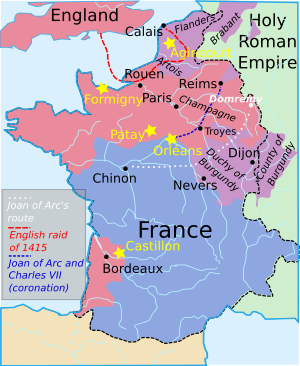
In 1429, the situation in France changed greatly. The town of Orléans had been under siege by the English since October 1428. French lords and soldiers who supported Charles were becoming very desperate.
Then, in a small village called Domrémy, a teenage girl named Joan of Arc (Jeanne d'Arc) appeared. She said that angels and saints had given her a special mission from God. She demanded that the local commander help her get to Charles at Chinon. Joan was given an escort and a letter. She arrived to see Charles on 23 February 1429.
It is said that Charles wanted to test Joan. He disguised himself among his courtiers. But Joan immediately recognized him. She bowed to him and said, "God give you a happy life, sweet King!" After they spoke privately, Charles felt inspired and full of confidence.
After meeting Charles, Joan of Arc went to lead the French forces at Orléans. She was helped by skilled commanders. They forced the English to end the siege on 8 May 1429. This was a turning point in the war. The French then won the Battle of Patay on 18 June, where the English lost about half their army. After these victories, Charles was crowned King Charles VII of France in Reims Cathedral on 17 July 1429.
Joan was later captured by Burgundian troops in 1430. The Burgundians handed her over to their English allies. She was put on trial for heresy by pro-English church leaders. Joan of Arc was burned at the stake on 30 May 1431.
French Victory
Besides Joan of Arc, Charles also had strong support from his wife's wealthy family, especially his mother-in-law, Queen Yolande of Aragon.
In 1435, Charles VII and Philip the Good, the Duke of Burgundy, signed the Treaty of Arras. With this treaty, the Burgundians ended their alliance with the English and made peace with Charles VII. This was a huge success for Charles. It meant that no important French noble would recognize the English King Henry VI as the King of France.
Over the next twenty years, the French army took back Paris from the English. Eventually, they recovered almost all of France. The only part the English still held was the northern port of Calais.
Later Years
Charles's later years were marked by problems with his son and heir, Louis. Louis wanted more power, but Charles always refused him. Because of this, Louis often caused trouble and made plans to weaken his father's rule. Louis even argued with Charles's mistress, Agnès Sorel. Eventually, in 1446, Charles sent Louis away to the Dauphiny region. They never met again. Louis refused to return to court when his father asked. He eventually fled to the protection of Philip the Good, Duke of Burgundy, in 1456.
In 1458, Charles became ill. He had a sore on his leg that would not heal, which caused a serious fever. The king asked Louis to come to him, but Louis refused. Charles remained ill for two and a half more years. He became very weak and believed he was surrounded by traitors. An infection in his jaw caused a large swelling in his mouth. For the last week of his life, Charles could not swallow food or water. He died on 22 July 1461, at Mehun-sur-Yèvre. He was buried next to his parents in Saint-Denis.
Legacy
Even though Joan of Arc is very famous, Charles VII achieved great things for France. He succeeded in something that his ancestors had tried and failed to do for generations. He expelled the English from France and ended the Hundred Years' War.
Charles VII also created France's first standing army since Roman times. This was a professional army that was always ready, not just called up for wars. The writer Niccolò Machiavelli later said that if Charles's son, Louis XI, had continued this policy, France would have been unbeatable.
Charles VII also made sure that the French king had power over the church in France, not just the Pope. He established the University of Poitiers in 1432. His policies also helped bring economic growth and wealth to his people.
Family
Children
Charles married his second cousin Marie of Anjou on 18 December 1422. They had fourteen children:
| Name | Birth | Death | Notes |
|---|---|---|---|
| Louis | 3 July 1423 | 30 August 1483 | King of France. Married Margaret of Scotland (no children) and Charlotte of Savoy (had children). |
| John | 19 September 1426 | Lived only a few hours. | |
| Radegonde | 1425 or August 1428 |
February 1445 | Was engaged to Sigismund, Archduke of Austria. |
| Catherine | 1428 | 13 September 1446 | Married Charles the Bold. |
| James | 1432 | 2 March 1437 | Died when he was five years old. |
| Yolande | 23 September 1434 | 23/29 August 1478 | Married Amadeus IX, Duke of Savoy, had children. |
| Joan | 4 May 1435 | 4 May 1482 | Married John II, Duke of Bourbon, no children. |
| Philip | 4 February 1436 | 11 June 1436 | Died as a baby. |
| Margaret | May 1437 | 24 July 1438 | Died when she was one year old. |
| Joanna | 7 September 1438 | 26 December 1446 | Twin of Marie, died when she was eight. |
| Marie | 7 September 1438 | 14 February 1439 | Twin of Joanna, died as a baby. |
| Isabella | 1441 | Died young. | |
| Magdalena | 1 December 1443 | 21 January 1495 | Married Gaston of Foix, Prince of Viana. |
| Charles | 12 December 1446 | 24 May 1472 | Died without legitimate children. |
Mistresses
- Agnès Sorel, with whom he had three daughters:
- Marie
- Charlotte
- Jeanne
- Antoinette de Maignelais
Ancestors
| Ancestors of Charles VII of France | ||||||||||||||||||||||||||||||||||||||||||||||||||||||||||||||||||||||||||||||||||||||||||||||||||||||||||||||||||||||||||||||||||||||||||||||||||||||||||||||||||||||||||||||||||||||||||||||||||||||||||||||||||||||||||||||||||||||||||||||||||||||||||||||||||||||||||||||||||||||||||||||||||||||||||||||||||||||||||||||||||||||||||||||||||||||||||||||||||||||||||||||||||||||||||||||||||||||||||||||||||||||||||||||||||||||||||||||||||||||||||||||||||||||||||||||||||||||||||||||||||||||||||||||||||||||||||||||||||||||||||||||||||||||||||||||||||||||||||||||||||||||||||||||||||||||||||||||||
|---|---|---|---|---|---|---|---|---|---|---|---|---|---|---|---|---|---|---|---|---|---|---|---|---|---|---|---|---|---|---|---|---|---|---|---|---|---|---|---|---|---|---|---|---|---|---|---|---|---|---|---|---|---|---|---|---|---|---|---|---|---|---|---|---|---|---|---|---|---|---|---|---|---|---|---|---|---|---|---|---|---|---|---|---|---|---|---|---|---|---|---|---|---|---|---|---|---|---|---|---|---|---|---|---|---|---|---|---|---|---|---|---|---|---|---|---|---|---|---|---|---|---|---|---|---|---|---|---|---|---|---|---|---|---|---|---|---|---|---|---|---|---|---|---|---|---|---|---|---|---|---|---|---|---|---|---|---|---|---|---|---|---|---|---|---|---|---|---|---|---|---|---|---|---|---|---|---|---|---|---|---|---|---|---|---|---|---|---|---|---|---|---|---|---|---|---|---|---|---|---|---|---|---|---|---|---|---|---|---|---|---|---|---|---|---|---|---|---|---|---|---|---|---|---|---|---|---|---|---|---|---|---|---|---|---|---|---|---|---|---|---|---|---|---|---|---|---|---|---|---|---|---|---|---|---|---|---|---|---|---|---|---|---|---|---|---|---|---|---|---|---|---|---|---|---|---|---|---|---|---|---|---|---|---|---|---|---|---|---|---|---|---|---|---|---|---|---|---|---|---|---|---|---|---|---|---|---|---|---|---|---|---|---|---|---|---|---|---|---|---|---|---|---|---|---|---|---|---|---|---|---|---|---|---|---|---|---|---|---|---|---|---|---|---|---|---|---|---|---|---|---|---|---|---|---|---|---|---|---|---|---|---|---|---|---|---|---|---|---|---|---|---|---|---|---|---|---|---|---|---|---|---|---|---|---|---|---|---|---|---|---|---|---|---|---|---|---|---|---|---|---|---|---|---|---|---|---|---|---|---|---|---|---|---|---|---|---|---|---|---|---|---|---|---|---|---|---|---|---|---|---|---|---|---|---|---|---|---|---|---|---|---|---|---|---|---|---|---|---|---|---|---|---|---|---|---|---|---|---|---|---|---|---|---|---|---|---|---|---|---|---|---|---|---|---|---|---|---|---|---|---|---|---|---|---|---|---|---|---|---|---|---|---|---|---|---|---|---|---|---|---|---|---|---|---|---|---|---|---|---|---|---|---|---|---|---|---|---|---|---|---|---|---|---|---|---|---|---|---|---|---|---|---|---|---|---|---|---|---|---|---|---|---|---|---|---|---|---|---|---|---|---|---|---|---|---|---|---|---|---|---|---|---|---|---|---|---|---|---|---|---|---|---|---|---|---|---|---|---|---|---|---|---|---|---|---|---|---|---|---|---|---|
|
||||||||||||||||||||||||||||||||||||||||||||||||||||||||||||||||||||||||||||||||||||||||||||||||||||||||||||||||||||||||||||||||||||||||||||||||||||||||||||||||||||||||||||||||||||||||||||||||||||||||||||||||||||||||||||||||||||||||||||||||||||||||||||||||||||||||||||||||||||||||||||||||||||||||||||||||||||||||||||||||||||||||||||||||||||||||||||||||||||||||||||||||||||||||||||||||||||||||||||||||||||||||||||||||||||||||||||||||||||||||||||||||||||||||||||||||||||||||||||||||||||||||||||||||||||||||||||||||||||||||||||||||||||||||||||||||||||||||||||||||||||||||||||||||||||||||||||||||
See also
 In Spanish: Carlos VII de Francia para niños
In Spanish: Carlos VII de Francia para niños
- Journal d'un bourgeois de Paris
Images for kids
-
Charles VII shown by Jean Fouquet as one of the three Magi.


